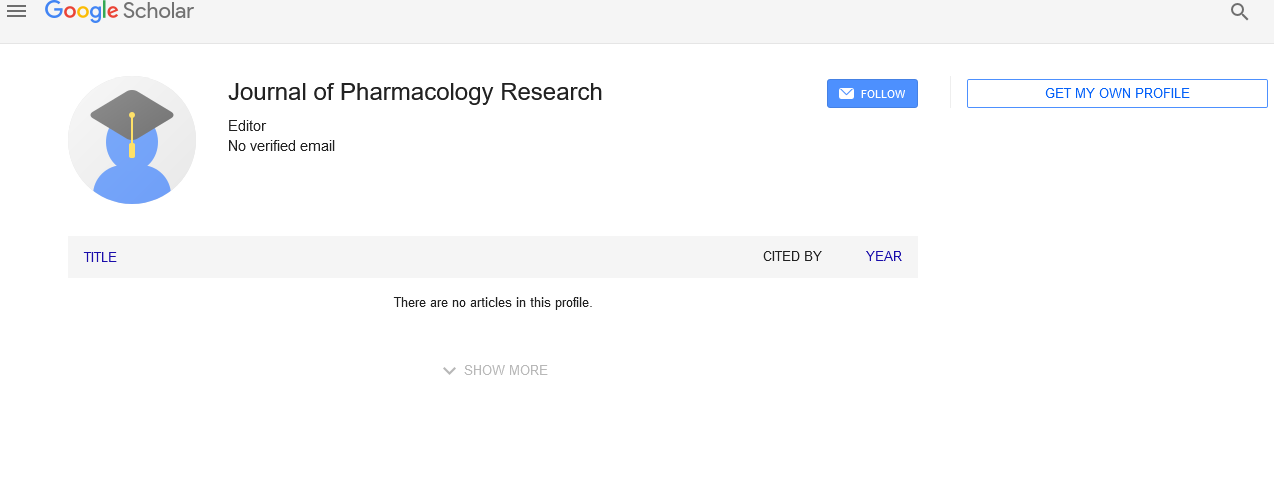All submissions of the EM system will be redirected to Online Manuscript Submission System. Authors are requested to submit articles directly to Online Manuscript Submission System of respective journal.

Sign up for email alert when new content gets added: Sign up
Abstract
Pharmacology 2019: Medicinal plants and possibility of pharmaceutical manufacture of improved traditional medicines - Tsabang Nolé- The Universty of Yaounde
Author(s): Tsabang NoléNatural products and traditional medicines are of great importance. This study aims to review the literature on the connection among natural products, traditional medicines, and modern medicine, and to explore the possible concepts and methodologies from natural products and traditional medicines to further develop drug discovery. Traditional medicines have been increasingly used by diverse communities in many parts of the world, due to its important role in maintaining good health with increasing awareness and research. Traditional medicine refers to health practices, approaches, knowledge and beliefs incorporating plant, animal and mineral based medicines, spiritual therapies, manual techniques and exercises, applied singularly or together to treat, diagnose and prevent illnesses or maintain well-being. In the last decade traditional medicine has become very fashionable in Cameroon, partly thanks to the long unsustainable economic situation within the country. The global market price of medicinal plant products exceeds $100 billion once a year . This paper discusses the role, contributions and usefulness of medicinal plants in tackling the diseases of public health importance, with particular emphasis on the present strategic approaches to disease prevention. A comparison is drawn between the ‘whole population’ and ‘high-risk’ strategies. Despite recent scientific advancement and globalization, the system of traditional medicine and complementary/alternative medicine is considered as a primary health care modality in the resource-constrained health care settings. Herbal medicinal system has been postulated and established through empirical observation and trial and error experiments since time out of mind to take care of good health and alleviate ailments and diseases. Since ancient times, people have suffered great loss of life due to cancer, malaria, childhood diseases, cholera, sleeping sickness, various infections and genetic diseases. The herbal medicine of early men worldwide allowed them to survive until the production of western drugs. Nowadays emergent and resurgent diseases as well as resistance of certain pathogens to usual antibiotics can find solutions in traditional medicines. Therefore, for the world’ needs of new phytodrugs, more efficient, not toxic and very cheap, tropical forests can supply pharmaceutical laboratories with several plants with astonishing medical values. Unfortunately, herbal medicines are very bad prepared by local therapists. The objective of this work was to select an antihyperglycemic plant as example and document the different stages of a standard preparation of improved herbal medicine. To achieve this objective, an ethnopharmacological survey conducted near 146 local therapists, has permitted to choose an herbal recipe using by late madam Tapongou Martine of Fongo-Tongo, West Region of Cameroon. The principal characteristic of this recipe is the minimum quantity of Laportea ovalifolia aerial parts used successfully to release diabetics previously diagnosed by medical doctors to avoid overdoses. The different stages of preparation are: 1- Plant identification according to the international rules of binomial nomenclature. 2- Research of non-toxicity of the recipe 3- Verification of therapeutic indication of the plant 4- Determination of standardized recipe with the quantity of decoction take one time 5- Determination of posology by liophilisation which is the mean of 250 ml of decoction taken one 10 times 6- Use of this posology to prepare gelules, tables, powder in sachet and aqueous form. Others forms of herbal medicine like suppositories, drops, inhalers, topical medicines (creams, lotions or ointments) and injection through nanotechnology is possible from established doses. Relationship between the four forms: 2 tables = 3 gelules = 1 sachet of lyophilized powder = 10 ml of liquid. Generally herbal medicines prepared following these stages are synergistic products that are improved throughout standardization and stabilization. Introduction Biodiversity is the foundation of human survival, and economic well-being. It also constitutes the bioresources upon which individuals, families, communities, nations and future generations depend .The existing knowledge of ethnic medicines has developed several leads in health care and drug discovery, and as a pattern for discovery .Traditional, complementary and alternative medicines attract the full spectrum of reactions. Yet, the use of traditional,complementary and alternative medicine is increasing rapidly in developing countries. In many parts of the planet, policy-makers, health professionals and therefore the public are wrestling with questions on the security, efficacy, quality, availability, preservation and further development of this sort of health care. The Institute of Medical Research and Medicinal Plants Studies and different Faculties of Medicine and Biomedical Sciences in Cameroon, encourage strongly innovated initiatives in the field of development of ITM. Many medicinal plants including Prunus afrinana, Pausinystalia yoimbe, Morinda lucida, Laportea ovalifolia, balsam pear, periwinkle and Moringa oleiracea are commonly utilized in traditional medicine .Such plants with established clinical effects have been actively studied in laboratories and some of them exported. Meanwhile, almost 90% of African countries which suffer from biodiversity erosion and climate changes, and emergence and reemergence of human diseases, depend on foreign pharmaceutical industries and laboratories, and therefore are in great need of latest ITM from these medicinal plants. Laportea ovalifolia is employed in traditional medicine in Cameroon to treat diabetes. Previous studies with diabetic rats have shown that this plant species is non-toxic, and produces hypoglycemic activities characterized by significant




